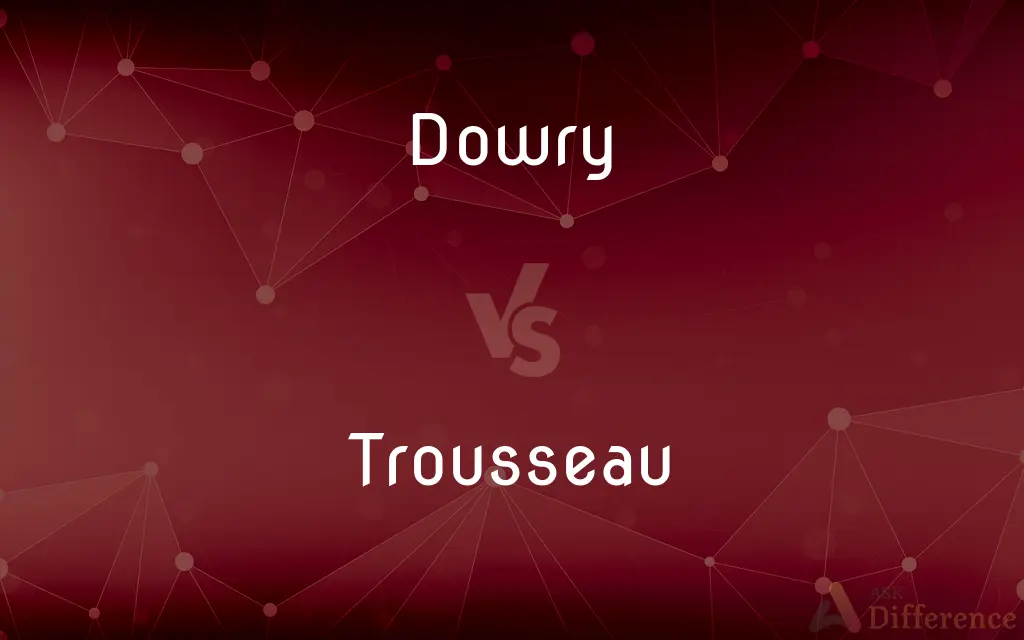Dowry vs. Trousseau — What's the Difference?
Edited by Tayyaba Rehman — By Fiza Rafique — Updated on March 26, 2024
A dowry is a transfer of parental property or wealth to a daughter at her marriage, while a trousseau consists of the clothes, linens, and other belongings collected by a bride for her marriage.

Difference Between Dowry and Trousseau
Table of Contents
ADVERTISEMENT
Key Differences
The concept of a dowry involves the practice of giving property, money, or a combination of assets from the bride's family to the groom or his family, traditionally seen as a way to ensure financial security for the bride. On the other hand, a trousseau refers specifically to the collection of items that a bride assembles for her married life, including clothing, lingerie, linens, and sometimes household items.
Historically, dowries were critical for a marriage agreement in many cultures, serving as a form of protection for the bride and a way to ensure her comfort and support in her new life. The trousseau, in contrast, was a demonstration of the bride's domestic skills and her family's wealth and status, often including handmade items that the bride prepared herself or with the help of female relatives.
In modern contexts, the significance and practice of giving dowries have changed and are even legally prohibited in some places due to concerns over gender equality and exploitation. The trousseau, while still a tradition in some cultures, has also evolved, with brides now often selecting and purchasing their trousseau items themselves, focusing on fashion, personal style, and the needs of the couple's future home.
The dowry system can be associated with social and economic pressures on the bride's family, sometimes leading to negative consequences if the dowry is deemed insufficient. Conversely, the preparation of a trousseau is generally viewed as a joyful, celebratory activity, emphasizing the bride's transition into married life rather than a financial transaction.
Both dowries and trousseaus reflect the cultural practices surrounding marriage, highlighting the ways in which societies prepare for and value the institution. While their purposes and implications can differ greatly, each tradition provides insight into the societal expectations of marriage and the roles of women within those societies.
ADVERTISEMENT
Comparison Chart
Definition
Transfer of wealth from the bride's family to the groom or his family.
Collection of clothes, linens, and belongings prepared by a bride for her marriage.
Purpose
Ensure financial security for the bride, support the couple.
Prepare the bride for her married life, showcase domestic skills.
Contents
Money, property, jewelry, and other assets.
Clothing, lingerie, linens, household items.
Cultural Significance
Varied; often related to marriage agreements and bride's protection.
Reflects bride's preparation and family's status; often includes handmade items.
Modern Practice
Decreasing, legally banned in some places due to concerns over exploitation.
Evolved with focus on personal style and needs of the couple's home.
Implications
Associated with social and economic pressures; can have negative consequences.
Seen as a celebratory preparation for marriage; less tied to financial transactions.
Compare with Definitions
Dowry
The practice of dowry varies significantly across cultures.
In some cultures, the dowry is a crucial part of the marriage negotiations.
Trousseau
The personal collection of a bride, including clothes and linens for her marriage.
Her trousseau was filled with custom-made dresses and heirloom linens.
Dowry
Historically, dowries served as a form of protection for the bride.
The dowry ensured the bride would be financially secure in her new home.
Trousseau
A trousseau often showcases the bride's taste and family's status.
The elaborate trousseau reflected her family's wealth and her personal style.
Dowry
Dowries can include valuable assets like jewelry and cars.
Her family added a luxury car to the dowry as a gift to the groom.
Trousseau
Trousseaus can include a range of items, from lingerie to tableware.
The bride's trousseau included everything from silk robes to fine china.
Dowry
Modern views on dowries often focus on ethical concerns.
Activists campaign against dowry practices that put undue pressure on the bride's family.
Trousseau
Preparing a trousseau is a tradition in many cultures, symbolizing the bride's readiness for marriage.
Months before the wedding, she began assembling her trousseau with her mother's help.
Dowry
A financial or property gift given to the groom's family by the bride's family.
The dowry included land, gold, and a significant sum of money.
Trousseau
Modern brides personalize their trousseau to their preferences.
She selected a contemporary trousseau that included designer outfits and modern home essentials.
Dowry
A dowry is a payment, such as property or money, paid by the bride's family to the groom or his family at the time of marriage. Dowry contrasts with the related concepts of bride price and dower.
Trousseau
The possessions, such as clothing and linens, that a bride assembles for her marriage.
Dowry
Money or property brought by a bride to her husband at marriage.
Trousseau
The clothes and linen, etc., that a bride collects or that is given to her for her wedding and married life, especially a traditional or formal set of these.
Dowry
A sum of money required of a postulant at a convent.
Trousseau
(obsolete) A bundle.
Dowry
A natural endowment or gift; a talent.
Trousseau
The collective lighter equipments or outfit of a bride, including clothes, jewelry, and the like; especially, that which is provided for her by her family.
Dowry
(Archaic) See dower.
Trousseau
The personal outfit of a bride; clothes and accessories and linens
Dowry
Payment, such as property or money, paid by the bride's family to the groom or his family at the time of marriage.
Dowry
(less common) Payment by the groom or his family to the bride's family: bride price.
Dowry
(obsolete) Dower.
Dowry
A natural gift or talent.
Dowry
To bestow a dowry upon.
Dowry
A gift; endowment.
Dowry
The money, goods, or estate, which a woman brings to her husband in marriage; a bride's portion on her marriage. See Note under Dower.
Dowry
A gift or presents for the bride, on espousal. See Dower.
Ask me never so much dowry and gift, and I will give . . .; but give me the damsel to wife.
Dowry
Money or property brought by a woman to her husband at marriage
Common Curiosities
What might a modern trousseau include?
Contemporary trousseaus can include designer clothing, personal and household items, reflecting the bride's personal taste and the lifestyle of the couple.
What is the primary purpose of a dowry?
To ensure the financial security of the bride and support the couple, often reflecting social and economic agreements in marriage.
How do dowries and trousseaus reflect cultural values?
They embody societal expectations of marriage, gender roles, and the economic and social responsibilities of families in matrimonial arrangements.
How has the concept of the trousseau evolved over time?
While it once emphasized handmade items and domestic skills, modern trousseaus focus more on the bride's personal style and the needs of the couple's future home.
Are dowries still common today?
Their prevalence varies by culture and region, but legal restrictions and changing social norms have reduced their practice in many areas.
What are the consequences of dowry disputes?
Disputes over dowry can lead to social tension, legal battles, and in severe cases, harm to the bride or her family.
What are the legal implications of dowry practices?
In some countries, giving or receiving a dowry is illegal due to concerns over exploitation, gender inequality, and financial pressure on the bride's family.
Can a trousseau include gifts from others?
Yes, while traditionally prepared by the bride and her family, modern trousseaus can also include gifts from friends and relatives.
Is a trousseau considered a gift to the groom or his family?
No, the trousseau is intended for the bride's personal use, preparing her for married life rather than as a gift to the groom's family.
How do people in cultures without dowry traditions view the practice?
Views can vary widely, with some seeing it as a quaint tradition and others criticizing it for perpetuating gender inequalities and financial burdens.
Share Your Discovery

Previous Comparison
Dichotomy vs. Duality
Next Comparison
Open vs. CloseAuthor Spotlight
Written by
Fiza RafiqueFiza Rafique is a skilled content writer at AskDifference.com, where she meticulously refines and enhances written pieces. Drawing from her vast editorial expertise, Fiza ensures clarity, accuracy, and precision in every article. Passionate about language, she continually seeks to elevate the quality of content for readers worldwide.
Edited by
Tayyaba RehmanTayyaba Rehman is a distinguished writer, currently serving as a primary contributor to askdifference.com. As a researcher in semantics and etymology, Tayyaba's passion for the complexity of languages and their distinctions has found a perfect home on the platform. Tayyaba delves into the intricacies of language, distinguishing between commonly confused words and phrases, thereby providing clarity for readers worldwide.
















































